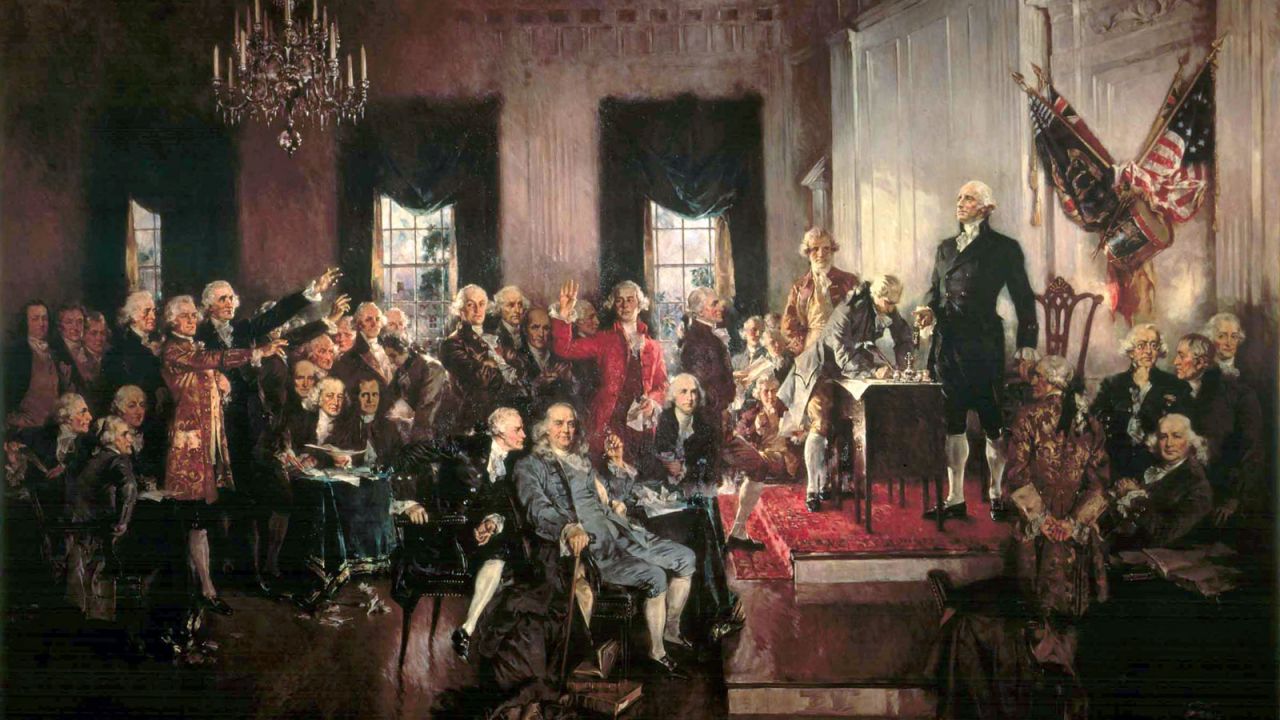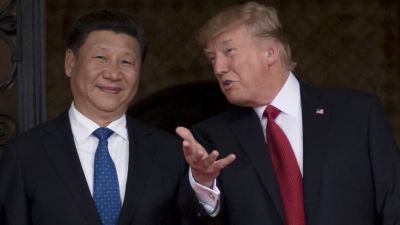
The Signing of the Constitution of the United States," with George Washington, Benjamin Franklin, and Thomas Jefferson at the Constitutional Convention of 1787; oil painting on canvas by Howard Chandler Christy, 1940. (Photo by GraphicaArtis/Getty Images)
Legal scholar Ganesh Sitaraman’s new book, The Crisis of the Middle-Class Constitution, is an important read in these times of increasing economic inequality. E.J. Dionnne tweeted: “To understand the stakes in the #Gorsuch confirmation battle and our larger judicial debate, read @GaneshSitaraman‘s brilliant new book.” Reviewing it for The New York Times, Nobel Prize winner Angus Deaton wrote, “In his fine book, both history and call to arms, Ganesh Sitaraman argues that the contemporary explosion of inequality will destroy the American Constitution, which is and was premised on the existence of a large and thriving middle class.”
Sitaraman makes the case that the founding fathers drafted the Constitution during a time in our history when those who were allowed to participate in democracy had relative economic equality. Over time, Sitaraman argues, as new groups were included in the process — freed slaves and women — and inequality grew, he tells Rebecca Rosen at The Atlantic, “they put serious pressure on the economic foundations of the Constitution.” To function properly, our government needs to find its base in a middle-class nation; inequality gums up the process, he argues. Which is why the next Supreme Court pick, especially one primed to favor corporations, creates more danger for the workings of the government, even potentially endangering key elements of the system the middle-class constitution has built.
In an extensive Q&A with The Atlantic, Sitaraman said:
Today with economic inequality the important topic that it is, I think the time is ripe for people to go back and think about, and be inspired by, the people who have come before us over many many generations, who saw that the Constitution required thinking seriously about economic inequality. And there’s lots of places we could think about this in our Constitution today. To take a simple example, a case like Citizens United uses the First Amendment in order to stop efforts, it seems, to make our political and economic system more equal by enabling corporations and wealthy people to have outsized power over the political process. We could think about a wide variety of constitutional provisions differently if we took this seriously — the Equal Protection Clause, the First Amendment, the 13th Amendment, which was seen by the Reconstruction Republicans as not just ending slavery but also empowering Congress to create economic opportunity for people who were struggling economically.
Sitaraman’s worries are being made manifest in the hearings for court nominee Neil Gorsuch. Sen. Sheldon Whitehouse (D-RI) had little luck in getting Gorsuch to weigh in on Citizens United, a performance lauded by the Wall Street Journal. Demos’ Heather McGee focused her testimony on Gorsuch’s “potential to be the deciding vote to destroy the few remaining protections against big money dominating our democracy.” Senate Minority Leader Chuck Schumer (D-NY) called for a filibuster and tweeted, “After careful deliberation, I have concluded that I cannot support Judge Neil Gorsuch’s nomination to the Supreme Court.”
Read an excerpt from Sitaraman’s book The Crisis of the Middle-Class Constitution, below.
Not the rise of presidential power. Not the growing national security state. Not the gridlock in Washington. Not the polarization of the two political parties. These are all important developments that shape how our constitutional system works. But it is possible to have a functioning constitutional republic with slightly more presidential power, or with a bigger military, or with fewer acts of Congress, or with a more polarized electorate. It is much harder to have a functional constitutional republic without a strong middle class.
What does the middle class have to do with preserving a republican form of government? From the ancient Greeks onward, political philosophers were preoccupied with the problem of economic inequality and its relationship to the structure of government. The wealthy elites would clash with everyone else — the rich oppressing the poor, the poor seeking to confiscate and redistribute the wealth of the rich. Economic inequality led inevitably to political inequality and, as a result, instability, class warfare and constitutional revolution.
Statesmen and philosophers therefore went to considerable lengths to design governments that would not fall prey to the tumults that accompanied economic inequality. The great republics throughout history — Rome, Florence, Venice, England — all had what we can think of as class warfare constitutions, governments designed on the assumption that economic inequality was inevitable and the clash between rich and poor inescapable. Class warfare constitutions experimented with many different designs to prevent economic conflict from spilling into constitutional revolution: Statesmen empowered special “tribunes,” representatives of the people, not drawn from the patrician class. They created bodies that represented different classes of people. And they sought to balance class power to prevent any one economic group from dominating the political system. Class warfare constitutions took as a premise that inequality would exist in society, and because inequality was a threat to stable government, they built checks into the constitutional structure itself.
The American Constitution is different. Our Constitution isn’t based on the assumption that class conflict is inevitable. Our Constitution is a middle-class constitution. Unlike the class warfare constitutions of earlier times, our Constitution assumes relative economic equality in society; it assumes that the middle class is and will remain dominant.
The framers of the Constitution were well aware of the history of statesmen and theorists grappling with class warfare. But they did not adopt a design premised on the inevitability of class conflict. In fact, our Constitution does not have a single provision — not one — that explicitly entrenches economic class into the structure of government. There is no provision excluding poor people from the Senate, and no provision excluding the rich from the House of Representatives. Class warfare constitutions had these kinds of features. Instead, from the time of the American Revolution through the creation of the Constitution, many Americans believed that the New World was unique because it had relative economic equality. There was neither extreme wealth nor extreme poverty, as was common in Europe. In fact, when compared with Europe, America’s special providence was clear: no feudalism, no nobility and no aristocracy-supporting land inheritance policies.
Americans, as Alexis de Tocqueville would later say, were born equal rather than becoming so. Americans understood and talked about this fact throughout the founding era, including during the debates over the ratification of the Constitution. Because the new American nation had readily available land to the west, there would be economic opportunity for anyone to own property and build an economic future. Of course, all of this was within the confines of the era’s views on equality between men and women and between races (more on that to come), but the big picture is that for 2,000 years class warfare defined the design of government. Then America came along.
The problem today is that the basic foundation upon which our middle-class constitution was built — the prerequisite of relative economic equality — is crumbling. More than eight years after the financial crash, disparities in economic power are at the forefront of popular debate. There is widespread concern about rising inequality and the increasing share of wealth going to the top 1 percent and 0.1 percent of people. In the past generation, the average worker hasn’t seen his income rise; adjusted for inflation, it’s been stagnant. People are working harder and harder, with gains in productivity and rising GDP but without an increase in wealth or economic security. Economic inequality is also turning into political inequality. Political leaders increasingly express a growing popular sentiment that “the system is rigged” to work for wealthy and corporate interests, who have the means to buy influence through campaign funding and then sustain their influence with “armies of lobbyists” in Washington. This outrage also isn’t partisan: it comes from both the populist right and the progressive left.
Worse yet, these populist concerns aren’t imagined. In a battery of studies over the last decade, political scientists have demonstrated that economic elites dominate the American political system. The wealthy participate more at every stage of the political process — from meeting candidates, to donating, to voting. Moneyed interests get greater access to elected officials and their staffs. Elite economic interest groups (business and industry) make up the majority of interest groups and spend the most money on lobbying. Political scientists have even shown that the majority’s views have effectively no impact on American public policy; the strongest predictor is the views of wealthy elites. These findings operate across all areas of policy, and they provide systematic evidence that politics is bent in favor of the wealthiest members of American society. They also raise a disturbing question: Can our constitutional system survive the collapse of the middle class?
For most of the history of constitutional thinking — the 2,300 years from the ancient Greeks into the modern era — the hardest, most intractable problem was at the nexus of social and constitutional structure: the economic division between rich and poor. Aristotle, Polybius, Cicero, Machiavelli and other political thinkers all paid considerable attention to how constitutional structure would intersect with economic inequality. They worried that economic inequality would lead to political inequality and, with it, oppression and ultimately revolution. Their primary answer was to develop mixed forms of government that built economic classes directly into the structure of government. Each class would thus have a stake in government and a check on the other.
But over time, some thinkers hypothesized another way out of the problem of inequality. Theorists in this second tradition recognized that if a society didn’t have economic inequality — if instead there was a strong, large middle class — it would be less likely to fall prey to economic divides. Freed from economic conflict, the sensible middle would hold the balance of power between a small number of wealthy and impoverished citizens. Under both traditions, the key feature was that the political structure had to mirror the distribution of wealth.
Why Economic Inequality Threatens the Republic
This book makes an unconventional argument about the American constitutional tradition. It argues that the American Constitution is based on the prerequisite that the nation has relative economic equality — a strong middle class, no extreme wealth or poverty, and economic opportunity. This might seem like a counterintuitive claim. For many people, the conventional understanding of our constitutional origins is that the Founding Fathers were wealthy white men who wrote the Constitution in order to preserve and promote their own interests. There is some truth to this story. But it isn’t the whole story, and it isn’t the whole truth.
In fact, when you think about it, this often accepted story about the Federalists’ Constitution — that it was a system devised to favor the elites — is really quite puzzling. Our Constitution doesn’t have any explicit provisions requiring that officeholders be from a specific economic class. It doesn’t even require that voters be from a specific class. With thousands of years of constitutional design explicitly incorporating economic class into the structure of government, the framers knew how to write such provisions. They had even done so in state constitutions during the 1770s and 1780s. But when it came to the federal Constitution of 1787, the framers didn’t build economic classes into the structure of government. If they really wanted to benefit themselves, why didn’t the framers go further?
The answer is that many of them didn’t want to — and even if they did, they couldn’t. During the time of the American Revolution, through the era of the Articles of Confederation, and into the ratification period and the early republic, there was a robust and strong belief that a truly republican form of government was only possible in a society with relative economic equality. Drawing on a long tradition in political philosophy, the founding generation understood that the balance of political power had to mirror the balance of economic power in society.
As a result, there were only two stable ways to design a government: Where there was inequality, there had to be a class warfare constitution. When there was relative equality in society, there could be a commonwealth or republic. Unlike Europe, with its hereditary nobility, property rules that concentrated wealth, and history of feudalism, America didn’t have centuries of entrenched wealth or poverty. With vast lands to the west and the possibility of education, any white man (at the time, of course, it was limited as such) had the opportunity to access the middle class. These beliefs weren’t just wishful thinking: economic historians have shown that the American colonies were remarkably equal for the late 18th century. With this intellectual commitment to — and the reality of — relative economic equality in the background, the American Constitution departed from a structure rooted in class warfare.
But that’s not the end of the story. As recent historians have shown, the politics and economics of the time also provided a brake on elite Federalists’ ambitions. The relationship between economic and constitutional structures was a lively part of the political debates over the ratification of the Constitution. Participants in those debates were well aware of the class warfare constitutions of the past, and they drew upon them in making arguments both for and against the proposed constitution. Anti-Federalists were concerned that the new constitution would lead to an aristocratic form of government, in which ordinary people had little power. They even proposed returning to the class warfare designs of the past to prevent such a development from taking place. The Federalists — who are usually seen as supporting elite interests — responded by rejecting the Anti-Federalists’ premise of inequality. They held that in America there were no classes and that the new constitution was rooted in the people themselves. This might have been good spin or smart campaign rhetoric, but the Federalists sold the Constitution — and won — with these arguments.
Perhaps most strikingly, the economic realities of the time supported the creation of a middle-class constitution. After the Revolutionary War, the new nation fell into a calamitous economic depression. Toward the end of the 1780s, virtually everyone was unhappy with the Articles of Confederation. Creditors, bondholders and many of the wealthiest Americans thought that the country needed better credit and wanted a stronger federal government. Many debtors, farmers and other ordinary Americans wanted a system of government that would be better able to alleviate the economic pressures on them. At the end of the day, surprisingly, the Constitution contained something for both sides. As we’ll see, at the heart of the Constitution was a practical solution to the economic crisis of the 1780s, one that used an obscure provision on tariffs to remove financial burdens from ordinary Americans and place them instead on wealthier merchants and those who purchased luxury goods. In contrast to two millennia of constitutions premised on class inequality, our Constitution was forged, in part, on trying to rebuild the economic fortunes of ordinary people.
If this account of the founding era seems unconventional, that’s because it is. But it wouldn’t have been at the time. The founding era was perhaps the richest moment in the life of American ideas. In the letters and speeches of the time, statesmen and even ordinary citizens sometimes sound more like scholars or philosophers than political hacks. They studied history, law, economics, politics, philosophy, all in service of the robust debate taking place on what kind of nation they would create. As a result, their debates feature an extraordinary diversity of political ideas. Looking back from the present, commentators often interpret the founding era through ideas associated with some of the most prominent political philosophers in history: Karl Marx, John Locke and Niccolò Machiavelli.
Devotees of Marx see society as mired in class conflict; in their version of the founding era, wealthy landowners designed a scheme of government that would preserve and promote their economic interests. Followers of John Locke emphasize instead a revolutionary tradition built on individual rights to life, liberty and private property, the absence of feudalism and the social contract. A third approach is inspired by Niccolò Machiavelli, one of the great theorists of republican government. The republicans argue that the founding generation valued freedom and self-government, and they believed a republic could only exist if the people and their leaders were virtuous citizens. Each of these leading traditions finds support in the historical evidence and brings a powerful perspective to understanding America’s past and present.

British philosopher James Harrington (1611-1677)
But there is another philosophical tradition, one that has largely been forgotten today but that was well-known to the founding generation. In the 17th century, the Englishman James Harrington argued that a republican form of government — what he called a commonwealth — could not exist without a relatively equal distribution of wealth. In all societies, Harrington said, power followed property. If property was concentrated in the hands of a few, the wealthy would eventually turn their economic power into political power, creating an aristocracy. Only if economic power was distributed widely among the people was a commonwealth, or republic, possible. Harrington’s understanding of the commonwealth stands on its own as a theme in the founding era, but it also overlaps with the more familiar interpretations of the founding. To Marxists, it acknowledges that the distribution of wealth matters. With Lockeans, it emphasizes the absence of feudalism and the relative equality of individuals. It is closest in its resemblance to republicanism, but it diverges by privileging the economic, not just the civic, preconditions for representative government.
Many in the founding generation had internalized Harrington’s lessons, and they believed that the American republic was built on America’s exceptional economic conditions — on the foundation of the middle class. For generations after the founding era, the tradition of the middle-class constitution remained alive. Political leaders and even ordinary Americans worried that rising inequality threatened America’s middle-class republic. The growth of a distinct rich and poor threatened republican government in two ways. When economic inequality existed, the wealthy would stop advocating for policies that promoted the common good. Instead, they would support — and use their resources to do whatever they could to promote — public policies that led to their private benefit. The wealthy would also begin to think they are inherently better than the poor and that they alone are worthy of the right to govern. The result of these dynamics is that the republic is corrupted and transformed, slowly and silently, into an oligarchy. The second threat came from the people’s response to the rise of the oligarchs. Suffering from economic anxiety and without political redress from a self-satisfied opulent elite, the people might turn to a demagogue who would overthrow the government — only to become a tyrant.
Oligarchy or tyranny, economic inequality meant the end of the republic.
From the book The Crisis of the Middle-Class Constitution by Ganesh Sitaraman, copyright 2017 by Ganesh Sitaraman. Published by arrangement with Alfred A. Knopf, an imprint of The Knopf Doubleday Publishing Group, a division of Penguin Random House LLC.




